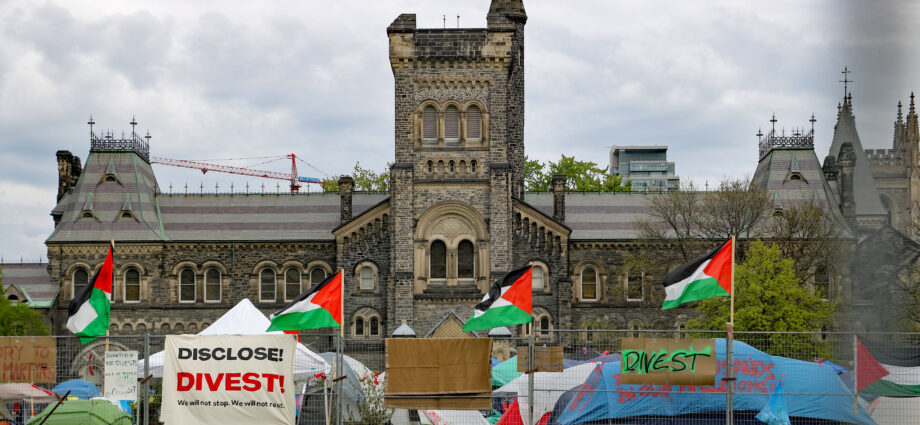
Geoff Callaghan, University of Windsor
May 30, 2024
The array of student encampments on university campuses in protest of Israel’s ongoing military operations in Gaza has raised another round of questions about the extent to which protest should be tolerated in liberal democracies — and under what circumstances.
It’s important to understand the nuances surrounding these protests. Some questions are, of course, easy to answer.
Do citizens have the right to protest? Absolutely.
Should protest be treated differently based on the message it wishes to promote? Save for incitements to violence and the flagrant promotion of hatred against an identifiable group, absolutely not.
But matters become more complicated when determining appropriate places for protests to be carried out and the length of time they should be allowed to continue.
The debate over the current student encampments is focused on these questions specifically.
Universities: Public or private property?
Questions of place often concern the distinction between public and private property. Since universities are situated on private property, so the argument goes, they should have the right, as a homeowner would, to evict people at their discretion.
But the matter isn’t as simple as that.
Courts are notoriously divided on the question of whether universities are public or private institutions and are consequently also divided on whether protections under Canada’s Charter of Rights and Freedoms — particularly the right to free expression and assembly — apply to them.
The Alberta Court of Appeal has declared the Charter does apply to campus-situated expression, while the Ontario and British Columbia Courts of Appeal have suggested the opposite.
But even if we put aside the issue of whether Charter protections do in fact extend to campus environments, it would be misguided to treat universities and private residences as equivalent because campus spaces are used in significantly different ways and for different purposes than people’s homes.
Even before property rights enter the discussion, a protest movement that took place in someone’s backyard would quickly lead to an uncontroversial and understandable claim of nuisance. People need to sleep, and they have a valid demand, especially in their homes, to be able to carry out their plans with relatively little obstruction from outsiders.
It is precisely for this reason that, even though the so-called Freedom Convoy protest was held in a public space in Ottawa, a court found it reasonable to grant an injunction aimed at reducing the excessive noise the protest inflicted upon residents in the area for several days.
The rationale wasn’t that the complainants had a right to dictate how public space was used — no individual or group in society should have that kind of authority — but that the particular way the space was being used by the protesters was causing a nuisance.
Urban campuses and university communities
University campuses do not face this same challenge — quite the opposite, in fact. Even those that are set within urban areas — like McGill University, the University of Toronto or my own institution, the University of Windsor — are large enough that they operate at a distance from anyone who isn’t part of the university community itself. As a result, the likelihood that a protest movement carried out in these spaces would cause a public nuisance is low.
The question then becomes whether the current encampments are causing excessive disturbances to the reasonable enjoyment and/or use of that space by others within the university community.
Although this question can only be answered on a case-by-case basis, it would appear that, to this point at least, arguments that have raised this concern have not been persuasive.

From my limited observations of the encampment at the University of Windsor, the way that protesters are using the university space is precisely in the way intended — they are hosting “teach-ins,” stimulating intellectual discussion and growth among participants, and generally demonstrating a high level of critical reflection on an ongoing humanitarian crisis. What more could university educators hope to instil in students?
That leaves the question of time — specifically, how long a protest action should be allowed to continue before the state intervenes. Many of the same space-related considerations help to clarify the matter.
State intervention
All things equal, it’s clear that the more disruptive a protest movement becomes to the enjoyment that others can reasonably expect from a given space, the stronger the argument is for state intervention.
But there is an important caveat here. Because protest movements can be so different from each other, it’s impossible to generalize when it comes to the relationship between disruption and state intervention.
As Irish legal scholar Illan rua Wall has convincingly argued, in order for protest movements to execute their communicative aims, they must by their very nature be disruptive.
Popular marches disrupt traffic; sit-ins disrupt business environments; students encamped on university campuses disrupt other uses that might be made of that space. To the extent that we, as a society, are committed to protecting the right of citizens to protest, we must also be prepared to tolerate its innately disruptive elements.
This sheds light on the time-related considerations that pertain to the student encampments. Unless and until the encampments become an unreasonably severe disruption to the enjoyment of university spaces by members of those communities, there is no time-related argument that supports state intervention.
Suggestions that participants have had ample time to make their point and should therefore “move along,” for example, ring as hollow as they are infantilizing.
Geoff Callaghan, Assistant Professor, Political Science, University of Windsor
Subscribe to our newsletter.
This article is republished from The Conversation under a Creative Commons license. Read the original article.

